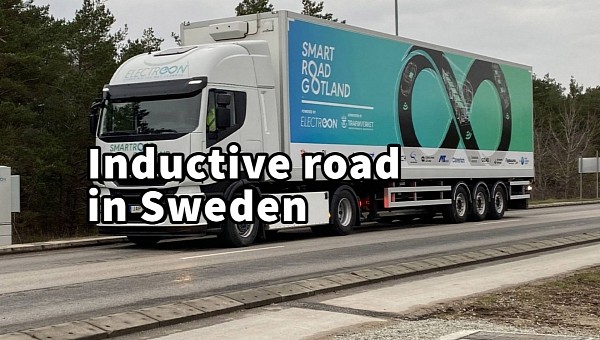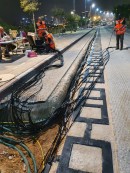Scientists from Chalmer University of Technology, Sweden, think the size of EV batteries can be reduced by up to 70% using electric roads. This would make them more affordable and efficient, maximizing the time spent on the road.
I remember when Mazda launched the MX-30, its first electric vehicle, and the PR people tried to promote the small battery as a feature, not a bug. They claimed you wouldn't need a bigger battery because the electric crossover would be used mostly in city traffic. Thus, you pay less for an electric vehicle, which is also more efficient and sustainable. It was a nice try, but the market proved me right: nobody wants a low-range EV. At least, not people who cannot afford a second car for family vacation trips. And those who do would rather opt for a longer-range EV in the first place.
Well, Mazda may have been well ahead of its time. An electric vehicle with a small battery can still prove attractive if charging it is not a problem. This can be achieved either by building fast charging stations every 60 miles (100 km) or a continuous inductive "station" that can charge the car along the way. I'm talking about an electric road fitted with inductive plates that can charge an EV while in motion. Both solutions are on the table in Europe now, at least for major routes in select markets.
Inductive roads have been considered expensive to build, considering the inductive plates that need to be embedded into the pavement. Integrating inductive charging in electric vehicles can also be difficult because EV makers must agree to a common standard. As we've seen with the CCS and NACS charging standards in North America, this would not be easy. If everyone can be brought on the same page, the benefits would be significant, as revealed by a new study from Chalmers University of Technology, Sweden.
The researchers have analyzed data from over 400 passenger cars to learn real driving patterns on different parts of Swedish national and European roads. Using this information, they have calculated the optimum battery size for electric vehicles when both inductive charging and fixed charging stations are used. The study showed that a combination of electric roads on 25 percent of the busiest national and European routes and home charging would be optimal. In this case, the EV batteries can be reduced to one-third of the current size. That's roughly the battery capacity of a Mazda MX-30.
Another benefit is spreading the load on the power grid throughout the day, although this might not necessarily be a good thing. If the grid relies heavily on solar power, charging at home at night is not desirable, and electric roads can help. Still, if other power sources are predominant, you'd want a fair amount of charging done at night, when the electricity is underused.
The study also shows that different groups of motorists have different needs, depending on their driving patterns and proximity to electric roads. "Even in the optimal case, some would manage with only electric road charging, while others would not be able to use the opportunity at all. For example, we see that those who live in the countryside would need almost 20 percent greater range on their batteries compared to those who live in a city center," says Wasim Shoman, one of the study's authors.
Well, Mazda may have been well ahead of its time. An electric vehicle with a small battery can still prove attractive if charging it is not a problem. This can be achieved either by building fast charging stations every 60 miles (100 km) or a continuous inductive "station" that can charge the car along the way. I'm talking about an electric road fitted with inductive plates that can charge an EV while in motion. Both solutions are on the table in Europe now, at least for major routes in select markets.
Inductive roads have been considered expensive to build, considering the inductive plates that need to be embedded into the pavement. Integrating inductive charging in electric vehicles can also be difficult because EV makers must agree to a common standard. As we've seen with the CCS and NACS charging standards in North America, this would not be easy. If everyone can be brought on the same page, the benefits would be significant, as revealed by a new study from Chalmers University of Technology, Sweden.
The researchers have analyzed data from over 400 passenger cars to learn real driving patterns on different parts of Swedish national and European roads. Using this information, they have calculated the optimum battery size for electric vehicles when both inductive charging and fixed charging stations are used. The study showed that a combination of electric roads on 25 percent of the busiest national and European routes and home charging would be optimal. In this case, the EV batteries can be reduced to one-third of the current size. That's roughly the battery capacity of a Mazda MX-30.
Another benefit is spreading the load on the power grid throughout the day, although this might not necessarily be a good thing. If the grid relies heavily on solar power, charging at home at night is not desirable, and electric roads can help. Still, if other power sources are predominant, you'd want a fair amount of charging done at night, when the electricity is underused.
The study also shows that different groups of motorists have different needs, depending on their driving patterns and proximity to electric roads. "Even in the optimal case, some would manage with only electric road charging, while others would not be able to use the opportunity at all. For example, we see that those who live in the countryside would need almost 20 percent greater range on their batteries compared to those who live in a city center," says Wasim Shoman, one of the study's authors.






